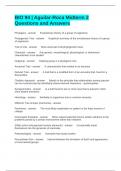BIO 94 | Aguilar-Roca Midterm 2
Questions and Answers
Phylogeny - answer Evolutionary history of a group of organisms
Phylogenetic Tree - answer Graphical summary of the evolutionary history of a group
of organisms.
Tree of Life - answer Most universal of all phylogenetic trees
Character - answer Any genetic, morphological, physiological, or behavioral
characteristic to be studied
Outgroup - answer Outlying group in a phylogenic tree
Ancestral Trait - answer A characteristic that existed in an ancestor
Derived Trait - answer A trait that is a modified form of an ancestral trait, found in a
descendant
Cladistic Approach - answer Based on the principle that relationships among species
can be reconstructed by identifying shared derived characters - synamorphies
Synapomorphy - answer Is a trait found in two or more taxa that is present in their
more distant ancestors
Homology - answer Similarity in organisms due to common ancestry
Different Tree Groups (memorize) - answer
Parsimony - answer The most likely explanation or pattern is the least amount of
change
Convergent Evolution - answer When natural selection favors similar solutions to the
problems posed by a similar environment rather than relatives
SINEs (short interspersed nuclear elements) - answer Occasionally insert
themselves into the genomes of mammals.
Paleontologists - answer Scientists that study fossiles
Precambrian Eon - answer Interval between the formation of Earth and appearance
of most animal groups
, Proterozoic Eon - answer First signs of present day oxygen levels, first algae,
sponges, photosynthetic eukaryotes (fossils), rocks containing oxygen.
Archaean Eon - answer First cyanobacteria, oxygenic photosynthesis,
photosynthetic cells, origin of LIFE
Hadean Eon - answer First oceans, heavy bombardment from asteroids ends, liquid
water on earth, Earth formation is complete, MOON FORMS, formation of solar system
Phanerozoic Eon - answer (Paleozoic, Mesozoic, and Cenozoic Eras) Formation of
animals and all the animals and fossils we see today
Paleozoic Era - answer (Cambrian, Permian) First arthropods, land plants, bony fish,
fish with jaws, tree size plants, tetrapods (amphibians), plants with seeds and leaves.
Adaption to land so lots of adaptive radiation
Mesozoic Era - answer (Triassic, Jurassic, Cretaceous) First nectar drinking insects,
dinosaurs (most dominant), mammals, bird like reptiles, flowering plant, water lilies,
bees and ants. Mass extinction at end
Cenozoic Era - answer HUMANS AND WHALES First horses (primates);
rabbits/hares, fully aquatic whales, apes, pollen, homo sapiens and chimpanzees
Adaptive Radiation - answer When a single lineage rapidly produces many
descendant species with a wide range of adaptive forms. This causes dramatic changes
in the tree of life. Can be observed as a sudden appearance of related, diverse species
in the fossil record.
Cambrian Explosion - answer When animals with shells, feet, heads, brains all
exploded into existence. The most spectacular period of evolutionary change in the
history of life.
Fauna - answer Collection of species
What triggered Cambrian Explosion - answer Higher oxygen levels (made aerobic
respiration more efficient, larger bodies could be formed), The evolution of predation
(new ways to attack prey, rapid movements, new defense mechanisms), New niches
beget more new niches (more and more new environments and preferred living
statuses), New genes, new bodies (
Mass extinction - answer Refers to rapid extinction of large number of lineages
scattered throughout the tree of life. Occurs when at least 60 percent of the species
presented are wiped out in 1 million years. Result from extraordinary, sudden, and
temporary changes in the environment.




